The Trust offers financial assistance to individuals or groups to carry through restoration or improvement projects to completion. The Trust also invites enquiries about sponsoring one or more Awards.

Tim Moore of Sandy, Bedfordshire - Merryweather Airship Construction Ladder
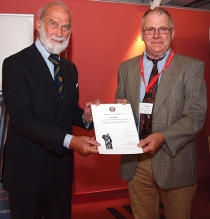
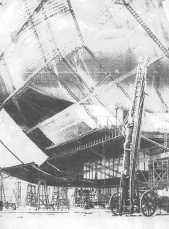
Awarded for the restoration of a huge, specialised, Merryweather ladder, used in the construction of the RAW R101 airship at Cardington, during the 1920s. This unique, approximately ninety year old contraption is the only known remaining example of the six to ten used in the huge No.1 hangar at RAS Cardington. It is a spectacularly large, mobile, wooden device, being capable of extending to around 90 feet, enabling engineers to work on the lower half of the 137ft diameter airship. The intention is to, ultimately, gift it to Bedford Town, for permanent public display and fund raising concerning Cardington Church, which have a strong connection with the loss of the R101 crew mausoleum and local charities. Work so far has been to rebuild the main carriage with its 5ft wheels. The work completed has been to an exacting standard (probably better than Merryweather managed in the first place) and it will be a very interesting and iconic item once done.
Paul Kirkbride from Liverpool - 1913 Admiralty Steam Tug Kerne
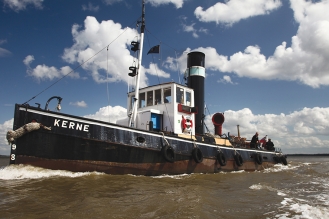
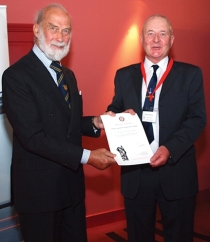 Steam Tug Kerne is a unique survivor of an Edwardian coal-fired steam lighterage tug. She has been run very successfully as a joint project with The North Western Steamship Co. Ltd and the Steam Tug Kerne Preservation Society Ltd, a registered charity for the last 45 years, and is designated as a National Historic Fleet Vessel by National Historic Ships. This designation puts the vessel in the highest category as a ship of pre-eminent national importance. From 1913 until 1948, she served as Admiralty steam tug HM Tug Terrier. She is the last remaining operational Royal Navy coal fired steamship to have seen service in the First World War. She later worked as a barge towing tug on the River Mersey and was the last coal fired vessel in commercial service on the river.
Steam Tug Kerne is a unique survivor of an Edwardian coal-fired steam lighterage tug. She has been run very successfully as a joint project with The North Western Steamship Co. Ltd and the Steam Tug Kerne Preservation Society Ltd, a registered charity for the last 45 years, and is designated as a National Historic Fleet Vessel by National Historic Ships. This designation puts the vessel in the highest category as a ship of pre-eminent national importance. From 1913 until 1948, she served as Admiralty steam tug HM Tug Terrier. She is the last remaining operational Royal Navy coal fired steamship to have seen service in the First World War. She later worked as a barge towing tug on the River Mersey and was the last coal fired vessel in commercial service on the river.
During an extensive HLF funded dry docking in 2015-2016 to replace hull plates in the boiler room, it was found that the replating encroached on the forward cabin which had to be stripped out completely. Volunteers stripped out the Edwardian Captain’s cabin internally by removing the original seating around the aft, port and starboard sides plus the floor and all the supporting timbers. In addition, the forward section of woodwork, which was fitted during misguided modernisation of the cabin in the early 1970s, was removed. The current project is to reinstate the cabin to its former glory, and the work will be completed to the highest conservation standard as set out in the book “Conserving Historic Vessels” published by National Historic Ships.
Douglas Miller - 1947 Leyland PS1 Single Deck Bus
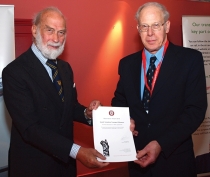
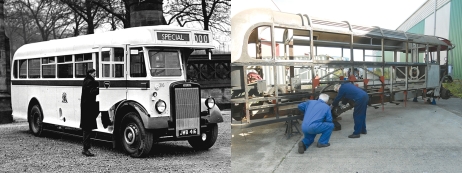 Built in 1947, fleet No.216, JWB 416, is the oldest surviving Sheffield Corporation bus. It is owned by the South Yorkshire Bus Museum and it is their desire to restore it to its original working condition. 216 was in the first batch of non-utility (i.e. wartime specification) buses to be bought by Sheffield Corporation after WW2, and was reputedly the first in this batch to be delivered. It was the first of its type in Sheffield, being a Leyland PS1 single deck bus with an unusual Weymann rear-entrance body. 216 served on Sheffield town services until 1957 when it was converted to a mobile canteen for Sheffield Corporation transport staff until 1968 when it was withdrawn. A dedicated team of volunteers has worked hard to strip the vehicle right back down and are in the process of rebuilding it to a very high standard, retaining as much originality as possible. They have a clear plan and a well thought through and realistic budget.
Built in 1947, fleet No.216, JWB 416, is the oldest surviving Sheffield Corporation bus. It is owned by the South Yorkshire Bus Museum and it is their desire to restore it to its original working condition. 216 was in the first batch of non-utility (i.e. wartime specification) buses to be bought by Sheffield Corporation after WW2, and was reputedly the first in this batch to be delivered. It was the first of its type in Sheffield, being a Leyland PS1 single deck bus with an unusual Weymann rear-entrance body. 216 served on Sheffield town services until 1957 when it was converted to a mobile canteen for Sheffield Corporation transport staff until 1968 when it was withdrawn. A dedicated team of volunteers has worked hard to strip the vehicle right back down and are in the process of rebuilding it to a very high standard, retaining as much originality as possible. They have a clear plan and a well thought through and realistic budget.
Mike Wrigley - 1938 Watson Class Lifeboat (ON-805 Salcombe)
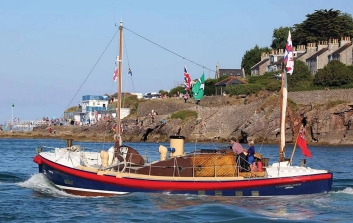
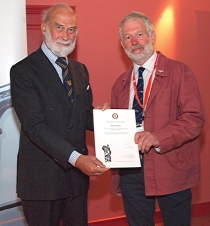 Built in Cowes in 1938, ON-805, The Samuel & Marie Parkhouse, is a Watson Class lifeboat, the first class of life saving vessel not to rely on sails. Few survive in original guise and are thus rare in this condition. This second generation vessel was designed to handle much shallower waters than previously. ON-805 served as Salcombe Lifeboat from 1938 until 1962. Now in private ownership in Salcombe, ON-805 has strong local significance and the present owner is painstakingly returning as much as possible to original specification and condition. This work is being completed to a very high standard and of particular note is the input that has been received from knowledgeable local experts; one such example was the return of the funnel to its original specification.
Built in Cowes in 1938, ON-805, The Samuel & Marie Parkhouse, is a Watson Class lifeboat, the first class of life saving vessel not to rely on sails. Few survive in original guise and are thus rare in this condition. This second generation vessel was designed to handle much shallower waters than previously. ON-805 served as Salcombe Lifeboat from 1938 until 1962. Now in private ownership in Salcombe, ON-805 has strong local significance and the present owner is painstakingly returning as much as possible to original specification and condition. This work is being completed to a very high standard and of particular note is the input that has been received from knowledgeable local experts; one such example was the return of the funnel to its original specification.
Highly Commended Category
Martin Shelley - 1909 Thornycroft 18hp Tourer
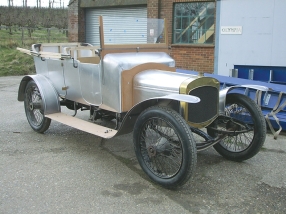
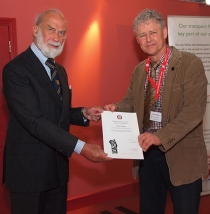 This is an amazing project with a superb pedigree, being restored by an utter enthusiast to a very high standard. The remains of the vehicle, which had been damaged in a bush fire, were purchased and imported in 2007, as an almost mechanically complete unrestored rolling chassis. The car was built by Sir John Isaac Thornycroft in Thornycroft’s Basingstoke factory as a special order for Lady Thornycroft’s second cousin, the remarkable ‘Cattle King’, Sir Sidney Kidman, who in 1908 owned over 100,000 square miles of Australian territory. Fortunately, the Thornycroft archives were to be scrapped and were acquired for the National Motor Museum library. Most of these archives were subsequently offered to Milestones Museum which was opened in Basingstoke in 1999, and the car’s current owner has had full access to these to assist with the restoration, allowing an excellent degree of authenticity and accuracy to be achieved. For the present, the car sports replica TT bodywork but the owner has had a correct replica of touring body constructed which will be fitted soon. Restoration has been undertaken to a high standard and mostly by the owner who has scrupulously followed the manufacturer’s original vision and specification. MoT-ed in April this year, the vehicle will attend the Prescott Hillclimb and the Thornycroft Run at Milestones Museum in Basingstoke in August, and the Bo’Ness Hillclimb Revival meeting in September.
This is an amazing project with a superb pedigree, being restored by an utter enthusiast to a very high standard. The remains of the vehicle, which had been damaged in a bush fire, were purchased and imported in 2007, as an almost mechanically complete unrestored rolling chassis. The car was built by Sir John Isaac Thornycroft in Thornycroft’s Basingstoke factory as a special order for Lady Thornycroft’s second cousin, the remarkable ‘Cattle King’, Sir Sidney Kidman, who in 1908 owned over 100,000 square miles of Australian territory. Fortunately, the Thornycroft archives were to be scrapped and were acquired for the National Motor Museum library. Most of these archives were subsequently offered to Milestones Museum which was opened in Basingstoke in 1999, and the car’s current owner has had full access to these to assist with the restoration, allowing an excellent degree of authenticity and accuracy to be achieved. For the present, the car sports replica TT bodywork but the owner has had a correct replica of touring body constructed which will be fitted soon. Restoration has been undertaken to a high standard and mostly by the owner who has scrupulously followed the manufacturer’s original vision and specification. MoT-ed in April this year, the vehicle will attend the Prescott Hillclimb and the Thornycroft Run at Milestones Museum in Basingstoke in August, and the Bo’Ness Hillclimb Revival meeting in September.
Following the presentations, HRH Prince Michael was taken for a short ride in the Thornycroft up to the historic banking.
Commemorative Awards:
The Commemorative awards are named after key founding members of the Transport Trust and represent the very best of the years nominated projects:
The David Muirhead Award
Eric Miles - 1928 Sentinel Shunter
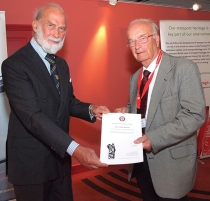
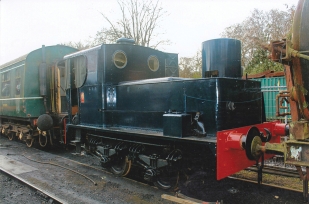 Originally supplied to Frys Somerville Chocolate Factory, this rare engine has been searched for, discovered, purchased recovered and now restored by a remarkable man, Mr Eric Miles, who was himself a worker at the Somerville factory, first as an engineer and more latterly in management. He has been instrumental in securing much funding and support for the project which has been undertaken by the Avon Valley Railway workshop. Funding has come from a variety of sources, not least a book by Mr Miles on the Somerville factory. Restoration has been completed thus far to a very high standard under the watchful eye of the Workshops Engineering manager. The locomotive is due to be steamed in 2017 so is well on the way to completion. The budget is taut but realistic and the engine will be based on the Avon Valley Railway where it is planned to run “chocolate specials” thus ensuring excellent public access.
Originally supplied to Frys Somerville Chocolate Factory, this rare engine has been searched for, discovered, purchased recovered and now restored by a remarkable man, Mr Eric Miles, who was himself a worker at the Somerville factory, first as an engineer and more latterly in management. He has been instrumental in securing much funding and support for the project which has been undertaken by the Avon Valley Railway workshop. Funding has come from a variety of sources, not least a book by Mr Miles on the Somerville factory. Restoration has been completed thus far to a very high standard under the watchful eye of the Workshops Engineering manager. The locomotive is due to be steamed in 2017 so is well on the way to completion. The budget is taut but realistic and the engine will be based on the Avon Valley Railway where it is planned to run “chocolate specials” thus ensuring excellent public access.
Alan Moore Award
John Porter - 7200 GWR 2-8-2 Tank Engine
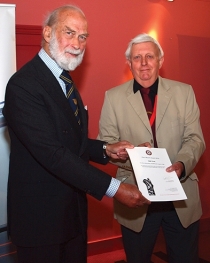
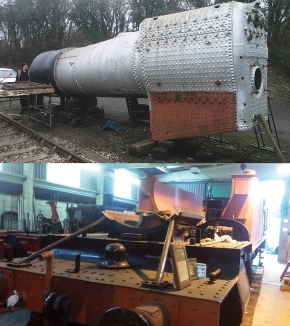
7200 is the prototype “72xx” class locomotive – a very large tank engine built by the GWR for freight and excursion duties. It is being heroically restored by a band of six at the Buckinghamshire Railway Centre. With the majority of the frames and running gear attended to, the team is turning its attention to the boiler. Originally designed as a 2-8-0, the loco was quickly modified to 2-8-2 to allow a longer tender and this is how the class then emerged. Two others survive - this is likely to be the first back in steam. The work has been on a monumental scale and the costs are similar – the group currently has a significant sum in the boiler fund but much more will be needed to complete the work, probably with professional boilersmith help. Nevertheless, the team’s personal dedication and input has been very significant indeed. It is a rare and unusual engine with some unusual features (such as the eight driving wheels). Its historical significance lies in its mundane but important role mainly hauling coal from Wales. Once restored, the aim is it display and use it on the Buckinghamshire line so public access will be excellent.
Sir Peter Allen Award
Graham Townsend - 1916 Aveling & Porter Roller
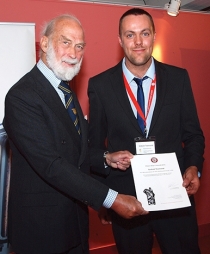
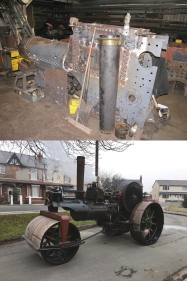 This is a steam road roller built in 1916 and exhibited at the Royal Show of that year before being sold to Morecambe UDC where one of its fist duties was to assist with the building of a munitions depot for the war effort. After a lengthy life in service, it was sold off for preservation in 1969. Like many engines though, preservation did not necessarily mean restoration and when the current owner purchased it in 2012, it needed extensive restoration work in all areas. Such restoration work is not that unusual, but the reason that this project stands out is that the 95% of the work has been done by the 25 year old owner in his spare time. The quality of workmanship that has been achieved by the young owner/restorer is exquisite and the engine flew through both its hydraulic and steam tests earlier this year. Work is now in hand to fit the lagging and canopy and paint and line the engine in its original livery before being widely rallied in 2017 where it will undoubtedly be much admired by the public.
This is a steam road roller built in 1916 and exhibited at the Royal Show of that year before being sold to Morecambe UDC where one of its fist duties was to assist with the building of a munitions depot for the war effort. After a lengthy life in service, it was sold off for preservation in 1969. Like many engines though, preservation did not necessarily mean restoration and when the current owner purchased it in 2012, it needed extensive restoration work in all areas. Such restoration work is not that unusual, but the reason that this project stands out is that the 95% of the work has been done by the 25 year old owner in his spare time. The quality of workmanship that has been achieved by the young owner/restorer is exquisite and the engine flew through both its hydraulic and steam tests earlier this year. Work is now in hand to fit the lagging and canopy and paint and line the engine in its original livery before being widely rallied in 2017 where it will undoubtedly be much admired by the public.
The Ron Wilsdon Award
Bob Wealthy - 1967 Britten Norman Islander G-AVCN
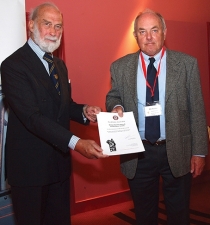
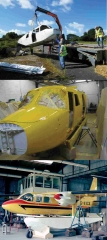 The Islander project remains a very long term one and the team of ex-BN employees are steadily completing the restoration against the backdrop of limited funds space constraints and so on. Nonetheless, progress has been good and the standard of workmanship is exemplary. The team is currently in what they describe as “Phase 2” which entails the wing, fin, rudder, tailplane, ailerons, elevator and flaps, including painting with the aim of presenting a fully assembled aircraft in time to celebrate the 50th anniversary of its first flight. Thereafter the team hopes to find a permanent home for the aircraft to be put on public display on the Isle of Wight. Given the profile of the aircraft in UK aircraft heritage and the proximity to completion, the project is a very important one.
The Islander project remains a very long term one and the team of ex-BN employees are steadily completing the restoration against the backdrop of limited funds space constraints and so on. Nonetheless, progress has been good and the standard of workmanship is exemplary. The team is currently in what they describe as “Phase 2” which entails the wing, fin, rudder, tailplane, ailerons, elevator and flaps, including painting with the aim of presenting a fully assembled aircraft in time to celebrate the 50th anniversary of its first flight. Thereafter the team hopes to find a permanent home for the aircraft to be put on public display on the Isle of Wight. Given the profile of the aircraft in UK aircraft heritage and the proximity to completion, the project is a very important one.
The National Transport Trust makes loans to groups, associations and individuals at advantageous rates for the restoration of artefacts - whether mobile or part of the infrastructure. Applications must be supported by a simple business plan which demonstrates the financial viability of the project. A sample business plan is available on request from the Treasurer.
The Trust does occasionaly make Awards for schemes which further the preservation movement. Again if you wish further information please contact the Treasurer.